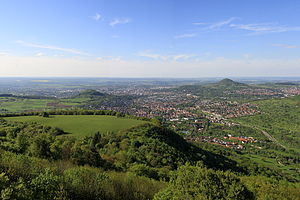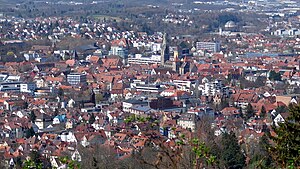Achalm
| Achalm | ||
|---|---|---|
|
View of the Achalm from the orchards to the southwest above Pfullingen |
||
| height | 706.5 m above sea level NHN | |
| location | Reutlingen , Baden-Wuerttemberg | |
| Mountains | Swabian Alb | |
| Coordinates | 48 ° 29 '39 " N , 9 ° 14' 38" E | |
|
|
||
| Type | Zeugenberg | |
| rock | White Jura | |
The Achalm ( 706.5 m above sea level ), the " local mountain " of the city of Reutlingen , Baden-Württemberg, is a witness mountain of the northern foreland of the central Swabian Alb in southwest Germany. On its summit there are sparse remains of the foundation walls of the medieval Achalm Castle of the same name , the former manor of the extinct noble family of the Counts of Achalm . The observation tower, built in 1838 as a replica of the keep , offers a panoramic view of Reutlingen, Eningen , Pfullingen , the northern foothills of the Alb and the northern edge of the central Swabian Alb , the Alb eaves . You can also see Tübingen , the Schönbuch and - on a clear day - to the Hornisgrinde in the northern Black Forest .
The eastern flank of the Achalm lies on the district of Eningen under Achalm , a direct neighboring municipality of Reutlingen.
As a so-called Zeugenberg (geological testimony / evidence of the prehistoric extent of the White Jura), the Achalm, with its characteristic conical shape, looks like an extinct volcano, similar to the 105 m lower Georgenberg , about 2.5 km to the southwest . Unlike the Georgenberg, the Achalm is not of volcanic origin, but, like the foothills of the Swabian Alb to the east, about 4 km away, consists of the sedimentary rocks of the brown and white Jura .
Name origin and derivation
According to legend, the name of the mountain or the former castle goes back to the last words of the lord of the castle, Count Egino, who was fatally hit as a result of an assassination attempt. In his agony, his last words were "Oh Allm ...", whereby he could no longer utter the intended exclamation "Oh Almighty!" Due to the occurring death. This legend was taken up by the romantic poet Ludwig Uhland in the eleventh stanza of the ballad The Battle of Reutlingen , with Uhland in the main context of his ballad the attack on the imperial city of Reutlingen by Count Ulrichs von Württemberg's army of knights around 200 years later - in the middle of the 13th century described.
However, it is more likely that the name comes from the old German term Ache (brook) an der Alm (mountain pasture). In contrast, the Germanist Hermann Fischer suspected a pre-Germanic origin of the name. In Reutlingen and the surrounding area there is also the form of the name “die Achel”.
History of the castle and the Achalm domain



From the 11th century on top of the Achalm Castle built the Earl Egino and Rudolf are only a few remains of walls and around 1838 rebuilt keep maintained. The castle fell into disrepair in the 15th century, but individual buildings were still inhabited until the 17th century.
During the Thirty Years 'War , Archduchess Claudia von Tirol ( Claudia de' Medici ) invoked her rights to the Achalm pledge and claimed about 30 Württemberg villages. She had these properties administered from Pfullingen Castle. On behalf of the archducal government in Innsbruck, the Pfullingen administrator Andreas Hildebrand demolished Achalm Castle in May 1645 to prevent it from being conquered by enemy soldiers. The only remaining building, a residential building above the gate, was completely destroyed by arson in August 1646. Only in the Peace of Westphalia did Duke Eberhard III. from Württemberg back the area of the Achalm pledge . After the end of the war, the castle walls were finally razed; In addition, many stones were used as building material for town houses.
A courtyard remained on the slope of the Achalm, which was built by Duke Eberhard III. 1650 was set up as a dairy. In the 18th century the Achalm came into the possession of private individuals.
King Wilhelm I of Württemberg bought the estate from the private owners in 1822 and had a sheep and goat breeding facility set up on the Achalm. Later, the court domain chamber, which was the authority responsible for the administration of the private assets of the royal family, was entrusted with the administration of the Achalm domain and had it managed by an employed administrator. High quality wool was produced on the Achalm. The domain was leased to a tenant since 1909, but the earnings situation on the barren mountain turned out to be difficult, although the tenant also ran a restaurant.
King Wilhelm I had a tower built on the foundation walls of the former keep. Threatened by decay, the Achalm Tower was restored in 1932 thanks to the Reutlingen Tourist Association and the initiative of its chairman Erwin Seiz, the Albverein and the voluntary labor service, and inaugurated in December 1932. The construction work, which began at the end of August, turned out to be difficult: apart from the water, which was pumped up from the domain with five vane pumps, all other construction materials, a total of 280,000 kilograms, were carried upwards. The conversion time took about 5,400 man days.

After the Second World War, Philip II Albrecht Duke of Württemberg decided to sell the domain. Since negotiations with the city of Reutlingen failed, the court chamber of the House of Württemberg sold the Achalm to the sheep farmer Theo Hausch in 1950. However, the city succeeded in persuading the new owner to cede the disk summit, which is located a little below the keep, together with the castle ruins. Today a hotel is operated on the top of the disk in front of the actual mountain cone of the Achalm. Most of the Achalm belonged to the Hausch family for decades. In June 2009, the city of Reutlingen bought all of their land. This means that (apart from the Eninger part and the hotel and restaurant operations) the entire mountain - which, like the Marienkirche or the Tübinger Tor, has long been a symbol of Reutlingen - is owned by the city.
Disk summit tunnel project
On August 18, 2009, 42 years after the first considerations of a corresponding city bypass road, construction work on the Scheibengipfeltunnel across the Achalm began after there had been fierce local political controversies about this project for a long time.
The preparatory work began in front of the south portal (district boundary to Pfullingen) at the approach for the tunnel boring. Construction of the tunnel itself began in 2011 and after its completion it was opened to public transport on October 27, 2017.
The tunnel route connects the Ifeu traffic junction (in the north of the Reutlingen-Mitte district ) with the south station (in the south-east). It has a connection to the federal highways in the direction of Tübingen ( B 28 ), Neckartal / Böblingen / Stuttgart ( B 464 ) and Metzingen / Ermstal ( B 312 / B 313 ) in the north, as well as Pfullingen and in the further course the Echaztal to the south ( B 312 / B 313) and Eningen to the east (Landesstraße 380).
The tunnel is designed to relieve traffic through Reutlingen's city center by around 20,000-25,000 vehicles per day. The feared traffic density through the Echaz valley immediately south of Reutlingen - especially at the narrowest point of the valley in Lichtenstein (Unterhausen and Honau suburbs), where the main road before the Albaufstieg runs through the middle of the core community and where planning a bypass has not yet seemed feasible - is still a regional and local political point of contention.
Personalities
- Ludwig Finckh , writer and poet, was buried halfway up the summit in 1964.
- HAP Grieshaber , visual artist, expressionist graphic artist and wood cutter, lived on the southern slope of the Achalm from 1947 until his death in 1981.
literature
- Carl Christian Gratianus: History of the Achalm and the city of Reutlingen in connection with the patriotic history (2 volumes) . Tuebingen 1831.
- Eberhard Fritz: The "Achalm Pfandschaft" owned by the Tyrolean line of the House of Habsburg. Expansion efforts in Upper Austria during the Thirty Years' War . In: Reutlinger Geschichtsblätter . tape 49 , 2010, p. 239-348 .
- Eberhard Fritz: The Achalm estate is owned by the House of Württemberg . In: Reutlinger Geschichtsblätter . tape 45 , 2006, p. 139-172 .
Web links
- Achalm. In: Johann Heinrich Zedler : Large complete universal lexicon of all sciences and arts . Volume 1, Leipzig 1732, column 312.
- Information and various image views of the Achalm (especially historical images)
- City of Reutlingen | Achalm Homepage of the city of Reutlingen
- Geotope profile at the State Office for Geology, Raw Materials and Mining
Individual evidence
- ↑ Map services of the Federal Agency for Nature Conservation ( information )
- ↑ official homepage of the city of Reutlingen about the Achalm
- ↑ Swabian dictionary / based on the Adelbert v. Keller started collections and edited with the support of the Württemberg State. by Hermann Fischer, 7 volumes, Laupp, Tübingen 1904–1936: Volume 1, 89.
- ^ Tenant: 1909–1921 Ernst Geiger, Schafhalter, Reutlingen; 1921–1926 Albert Münst, retired corvette captain. D., Tübingen; 1926–1950 Jakob Mayer, Hülbenhof, Anhausen municipality, Münsingen regional office.
- ↑ "I will climb to your heights ..." . In: Reutlinger Generalanzeiger. December 5, 1932, pp. 5-6.
- ↑ The Scheibengipfeltunnel officially opened ; Article in the Reutlinger Generalanzeiger from October 28, 2017


